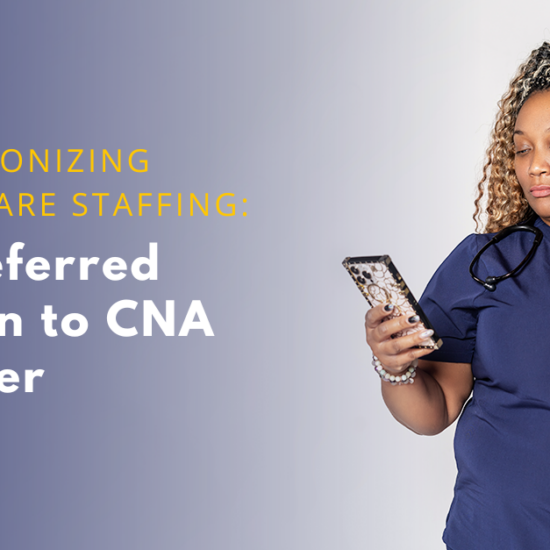5 Steps to Developing a Cost-Conscious Nursing Unit Budget that Prioritizes Quality Care & Staff Satisfaction
5 Steps to Developing a Cost-Conscious Nursing Unit Budget that Prioritizes Quality Care & Staff
Satisfaction
Balancing quality care and expenses is a relentless struggle that healthcare providers are all too familiar with. While patients are always the priority, inflation, wage pressures and lower reimbursement rates have left senior care organizations and hospitals with no choice but to get creative in cutting unnecessary costs. The good news is that nurses can play an active role in helping their employer achieve this through operational budgeting.
Healthcare organizations typically use a decentralized budget, where each community is empowered to make its own financial decisions based on the needs of the business. According to My American Nurse, “The operating budget is especially relevant to nurses because they’re closest to the patients and know what’s needed to provide the appropriate care and services on a daily basis. Each nursing unit is considered a cost center and has an operating budget, whose major components are revenues and expenses.” This model makes perfect sense in fast-paced healthcare environments where resident population and acuity fluctuates daily, and staffing needs must be quickly adjusted when they do.
Whether you’re a new nurse manager, or you’re a veteran looking for best practices to add to your toolkit, this blog will walk you through the key steps to creating a nursing unit budget you can stick to while prioritizing staff satisfaction and patient care.
Step 1: Do Some Research
Make friends with your finance department as you will be working closely with them on this effort. They are the team that will be monitoring your nursing unit budget and approving and unplanned expenses that arise throughout the year. You may even want to get involved in corporate budget planning sessions in the future.
Sit down with them to better understand the organization’s fiscal goals and how your unit can help achieve them. Have them pull your unit’s historical spending information. Key questions to ask include:
- How much did my unit spend last year and were we on budget?
- How does that compare to other units?
- Where was the bulk of the budget spent?
- Were there any unplanned, large expenses?
Step 2: Understand Your Expenses & Categorize Them Appropriately
Become an expert in budgeting. This will not only help you save the organization money but will earn the respect of your peers and give you a competitive edge. Start by understanding and categorizing your expenses based on the three different categories in healthcare budgets.
Capital Budget: These are larger expenses that are laid out in advance and factored into the yearly budget. Your capital spend might include new beds or an upgrade to patient bathrooms. Ideally, this number will not change over the year unless something urgent comes up.
Supply & Equipment Budget: This includes smaller-ticket items such as stethoscopes, hand sanitizer, pens and notepads, which are usually ordered at a regular cadence based on demand.
Staffing Budget: This one is the most dynamic of the three categories. You’ll want to evaluate staffing patterns from the previous year and lay out your approximately how much goes to staffing your unit. Be sure to account for busier shift times and the overnight shift. It’s wise to also look at overtime numbers from the previous year. The next step will help you reduce some of that.
Step 3: Look for Potential Cost Saving Opportunities
While your capital spend is static, the other two areas offer some wiggle room, especially staffing. Start by taking stock of the equipment and supplies you have on hand. If you have a surplus, you can change your delivery frequency. Work with your supplier to see if there are cheaper options for some items and if there are items you no longer need in your unit. Make sure to encourage staff to use supplies responsibly to conserve.
All nurses know that staffing for cost savings is a never-ending task. However, they also know that continuously monitoring staffing as resident population and acuity changes can make a huge dent in the unit and organization’s profitability. First things first: look for instant cost savings by reviewing the master schedule. Many facilities have overtime already built in, and this adds up week after week.
Approach your staff to see if they need to alter their schedule for any reason. Doing so might help you fill some gaps, promotes work/life balance and boosts retention. Ensuring your staff are happy with the days/times they work is a great way to kick off the new year (and to increase the likelihood they won’t call-off!)
Next, make sure your full-time, part-time and PRN staff are working to their max capacity (ie. 40 hours/week for full-timers) without going into overtime. If you have some open shifts as a result, approach your part-time workers about coming on board full-time and prioritize hiring for these slots. Ideally, you will have a master schedule free of overtime. This will offset the overtime cost associated with call-offs and occupancy changes throughout the week.
Finally, make sure you have a plan for when the inevitable call-off does come in. Rather than calling down a list of employees, identify a group of people that are willing to pick up extra shifts, ideally without incurring overtime. These might be your part-time workers who have expressed interest in more shifts but do not want to commit to full-time status.
If those people are unavailable, be cautious about defaulting to your hardworking, full-time staff members who are always willing to help. This puts these folks at risk of burning out which is detrimental to their health and can compromise patient care. A better option is to partner with an on-demand healthcare marketplace that offers affordable, highly qualified staff at a fraction of the cost of traditional agencies.
Step 4: Set Your Yearly Goals
You’ve done your due diligence researching your unit and have already implemented some quick-win cost-cutting strategies. You’re ready to put your pen to paper. It’s no surprise that Finance folks love detail so be as granular with your nursing unit budget as possible. Show simple equations for how you did the math and assign line items for just about everything you can think of. Consider involving your team and collecting their input in case you missed anything. After all, they are the ones closest to patients and might have some valuable insights or ideas.
It’s worth noting that while historic information should be considered in your plan, it should not have too much influence over your new budget. Remember, your goal here is to save the organization money while upholding its care standards. Keep that in mind as you get into the numbers. Consider communicating how you plan to keep a close eye on your unit’s spending and staff to budget to the best of your ability.
Next, share your plan with the approving parties. Once any adjustments are made and it’s finalized, provide visibility to staff. Make them aware of any changes from the previous year and how they can help you stay on track.
Step 5: Remain Diligent & Flexible
None of us know what the future holds. Equipment breaks, people call off, reimbursement rates change, and prices increase yet again. And oftentimes, those things seem to happen one right after the other. It’s important to remember that so much is out of your control so don’t be so hard on yourself if you don’t stay on budget the entire year. Focus on what you can control: adjusting staffing based on needs and being transparent about your progress. And finally, don’t be afraid to ask for help, from both your staff and leadership. Even though your budget is decentralized, the broader organization is working toward a common goal.
Think of managing the unit’s operating budget as your time to shine. You’ve been trusted by your superiors to own this critical process so let that motivate you each day!
The best way to stay on nursing unit budget? Utilizing NurseDash, the preferred staffing partner you at the facility, can depend on. Filling your facility’s shifts through NurseDash allows you to maximize revenue while providing consistent patient care. Click here to get started.
NurseDash is committed to your job success beyond budgeting and filling shifts. We offer our NDPros tools and resources to accelerate their careers. We have so many exciting things planned for the year ahead so stay tuned!






